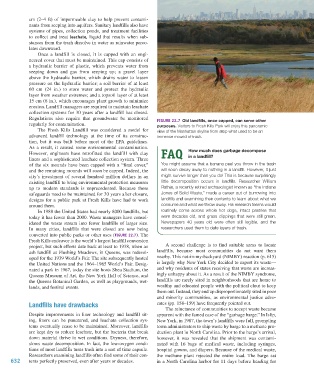Page 633 - Environment: The Science Behind the Stories
P. 633
cm (2–4 ft) of impermeable clay to help prevent contami-
nants from seeping into aquifers. Sanitary landfills also have
systems of pipes, collection ponds, and treatment facilities
to collect and treat leachate, liquid that results when sub-
stances from the trash dissolve in water as rainwater perco-
lates downward.
Once a landfill is closed, it is capped with an engi-
neered cover that must be maintained. This cap consists of
a hydraulic barrier of plastic, which prevents water from
seeping down and gas from seeping up; a gravel layer
above the hydraulic barrier, which drains water to lessen
pressure on the hydraulic barrier; a soil barrier of at least
60 cm (24 in.) to store water and protect the hydraulic
layer from weather extremes; and a topsoil layer of at least
15 cm (6 in.), which encourages plant growth to minimize
erosion. Landfill managers are required to maintain leachate
collection systems for 30 years after a landfill has closed.
Regulations also require that groundwater be monitored FIGURE 22.7 Old landfills, once capped, can serve other
regularly for contamination. purposes. Visitors to Fresh Kills Park will enjoy this panoramic
The Fresh Kills Landfill was considered a model for view of the Manhattan skyline from atop what used to be an
advanced landfill technology at the time of its construc- immense mound of trash.
tion, but it was built before most of the EPA guidelines.
As a result, it caused some environmental contamination.
However, engineers have retrofitted the landfill with clay FAQ How much does garbage decompose
liners and a sophisticated leachate collection system. Three in a landfill?
of the six mounds have been capped with a “final cover,” You might assume that a banana peel you throw in the trash
and the remaining mounds will soon be capped. Indeed, the will soon decay away to nothing in a landfill. However, it just
city’s investment of several hundred million dollars in an might survive longer than you do! This is because surprisingly
existing landfill to bring environmental protection measures little decomposition occurs in landfills. Researcher William
up to modern standards is unprecedented. Because these Rathje, a recently retired archaeologist known as “the Indiana
safeguards need to be maintained for 30 years after closure, Jones of Solid Waste,” made a career out of burrowing into
designs for a public park at Fresh Kills have had to work landfills and examining their contents to learn about what we
around them. consume and what we throw away. His research teams would
In 1988 the United States had nearly 8000 landfills, but routinely come across whole hot dogs, intact pastries that
today it has fewer than 2000. Waste managers have consol- were decades old, and grass clippings that were still green.
idated the waste stream into fewer landfills of larger size. Newspapers 40 years old were often still legible, and the
In many cities, landfills that were closed are now being researchers used them to date layers of trash.
converted into public parks or other uses (FIGURE 22.7). The
Fresh Kills endeavor is the world’s largest landfill conversion
project, but such efforts date back at least to 1938, when an A second challenge is to find suitable areas to locate
ash landfill at Flushing Meadows, in Queens, was redevel- landfills, because most communities do not want them
oped for the 1939 World’s Fair. The site subsequently hosted nearby. This not-in-my-backyard (NIMBY) reaction (p. 615)
the United Nations and the 1964–1965 World’s Fair. Desig- is largely why New York City decided to export its waste—
nated a park in 1967, today the site hosts Shea Stadium, the and why residents of states receiving that waste are increas-
Queens Museum of Art, the New York Hall of Science, and ingly unhappy about it. As a result of the NIMBY syndrome,
the Queens Botanical Garden, as well as playgrounds, wet- landfills are rarely sited in neighborhoods that are home to
lands, and festival events. wealthy and educated people with the political clout to keep
them out. Instead, they end up disproportionately sited in poor
and minority communities, as environmental justice advo-
Landfills have drawbacks cates (pp. 158–159) have frequently pointed out.
The reluctance of communities to accept waste became
Despite improvements in liner technology and landfill sit- apparent with the famed case of the “garbage barge.” In Islip,
ing, liners can be punctured, and leachate collection sys- New York, in 1987, the town’s landfills were full, prompting
tems eventually cease to be maintained. Moreover, landfills town administrators to ship waste by barge to a methane pro-
are kept dry to reduce leachate, but the bacteria that break duction plant in North Carolina. Prior to the barge’s arrival,
down material thrive in wet conditions. Dryness, therefore, however, it was revealed that the shipment was contami-
slows waste decomposition. In fact, the low-oxygen condi- nated with 16 bags of medical waste, including syringes,
tions of most landfills turns trash into a sort of time capsule. hospital gowns, and diapers. Because of the medical waste,
Researchers examining landfills often find some of their con- the methane plant rejected the entire load. The barge sat
632 tents perfectly preserved, even after years or decades. in a North Carolina harbor for 11 days before heading for
M22_WITH7428_05_SE_C22.indd 632 13/12/14 2:25 PM

